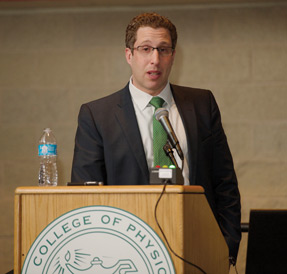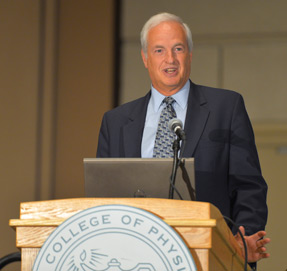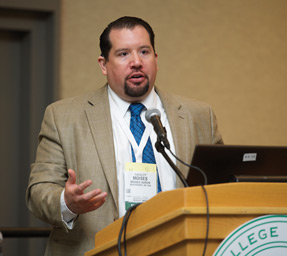Oncologic ‘horrors' can beset hospitalized patients
Common crises that can happen during the management of oncology patients include increased intracranial pressure, metabolic problems, infections, and toxic side effects from drugs. Learn how to manage these conditions.Exercise capacity is the single most power predictor of cardiovascular events, whether or not symptoms are present.
In what he called a “whirlwind tour of the horrors of medical oncology,” Christian T. Cable, MD, FACP, outlined the perils that may befall cancer patients, and what to do about them, in a session at Internal Medicine 2014, held in Orlando, Fla., in April.
“What could go wrong? The short answer is, a lot,” said Dr. Cable, who is the hematology/oncology fellowship director at Scott & White Healthcare in Temple, Texas, and associate professor of medicine at Texas A&M University Health Science Center in Temple. “I'll focus on the first 12 hours after patients present to the ED.”

Dr. Cable outlined typical problems that occur in the infectious, metabolic, drug, and mechanical realms.
Mechanical issues
Common crises that could be thought of as mechanical include increased intracranial pressure (ICP) from brain metastases, spinal cord compression, and superior vena cava syndrome, he said.
Patients with ICP from brain metastases often present with headache, as well as nausea, sleepiness, elevated blood pressure, and slow pulse. The diagnosis is made by MRI.
In a sample case, Dr. Cable described a 59-year-old man in remission from lung cancer after having been treated with surgery and adjuvant chemotherapy 1 year before. He presented with a weeklong headache, nausea without vomiting, and sleepiness.
On exam, the patient had a blood pressure of 190/95 mm Hg and a pulse of 45 beats per minute. His family described him as being “off” and “not himself.” His MRI showed multiple areas of changed signal density, which were read as multiple brain metastases.
The treatment for ICP is dexamethasone at an initial IV dose of 10 mg, with subsequent doses given orally, if swallowing ability allows. “The bioavailability is the same with the oral as the IV,” Dr. Cable noted.
Dosing is 4 mg 4 times a day in the hospital and 8 mg twice a day once discharged, since the lower frequency improves adherence, Dr. Cable said.
Neurosurgical consultation is appropriate for patients with low-volume disease, high performance status, and isolated metastases. A radiation oncology consultation is appropriate in cases of more extensive disease and for patients who are not good surgical candidates, he said.
“Radiotherapy requires going back and forth to the hospital 10 times for treatment,” Dr. Cable said. “If someone is very sick and dying, palliative care may be the better option.”
The chief symptom with spinal cord compression is usually back pain, although patients often also report a decreased ability to exercise, he said. “People will report that they used to be able to walk a mile in 20 minutes and now it takes 30, or that climbing a flight of stairs is difficult when it usually is not,” Dr. Cable said.
On physical exam, these patients are often tender in the upper lumbar spine, need to use their arms to rise from a chair (instead of being able to do so using just leg and trunk strength), and have brisk patellar reflexes—”perhaps too brisk,” Dr. Cable said.
It's important to do an MRI of the whole spine when diagnosing, because isolated cord compression is quite rare, he added. Treat with the same steroid dosing regimen as for brain metastases. Fit patients—that is, those who are able to walk, not be wheeled, into the hospital—are candidates for neurological consult, he said.
The more usual intervention, though, is radiation oncology consultation. “About 1 in 10 of the spinal cord compression patients go on to surgery in our practice,” he said.
Patients with superior vena cava (SVC) syndrome usually report difficulty breathing, often with exertion, and perhaps several days or weeks of night sweats. Physical examination may show slight tachypnea and tachycardia, bilateral firm supraclavicular lymph nodes, crisp heart tones, clear lungs, prominent chest wall veins, and a plethoric face, he said.
The gold standard for SVC treatment is chemotherapy or radiotherapy directed to the tumor, Dr. Cable said. SVC is often seen in small-cell lung cancer and lymphoma (Hodgkin or primary mediastinal non-Hodgkin lymphoma), he said.
Metabolic problems
Metabolic problems that lead to emergent treatment for cancer patients include tumor lysis syndrome (TLS) and hypercalcemia.
Abnormal labs are a red flag for TLS, particularly high creatinine, high potassium with early ECG changes (hyperkalemia), and high phosphorous levels—basically “an acute metabolic mess,” said Dr. Cable.
As an example, he described an elderly man who had received his first treatment for lymphoma on a Friday with TLS prophylaxis consisting of allopurinol and oral hydration. By Monday, his creatinine had almost tripled to 2.5 from 0.9 mg/dL; he had a potassium level of 5.7 mEq/L with early ECG changes (mild T-wave peaking) indicating hyperkalemia; his phosphorus was 13.1 mg/dL; and his calcium was 7.5 mg/dL.
“The patient's uric acid was 3 times lower than the limit reference range,” said Dr. Cable. “Like a bad oncologist, I told the patient to please go to the ED. But like a good oncologist, I called the ED to warn them about what was going on.”
If you ever suspect TLS in a patient, do a lab panel and if one of the labs is abnormal, put that patient in the hospital and monitor his or her electrolytes, he added.
For therapy, use IV hydration, noncalcium phosphate binders, and rasburicase, which is a recombinant enzyme that dramatically solubizes uric acid, he said. “With this, your phosphorus can go from 13 to 4 [mg/dL] in 4 hours,” he said.
If the TLS patient's case is severe, he or she should have telemetric monitoring and electrolyte assessments every 4 to 6 hours until stable, he added.
Malignant hypercalcemia patients will present with decreased mentation and may be sleepy. On physical examination, they will have elevated creatinine, low albumin, and a high calcium (approximately 16 mg/dL, for example), with associated risk of renal failure.
The first therapeutic priority is to rehydrate; if renal failure is present, hydration will often resolve it. “And, it seems obvious, but hold the calcium supplements,” Dr. Cable said. IV bisphosphonate should be given, as well: “It actually poisons the osteoclast,” he said.
In the hospital, pamidronate can be given—it's cheaper and better for the kidneys—while zoledronic acid is usually used for outpatients because it's fast.
Unfortunately, hypercalcemia with a known cancer diagnosis has a poor prognosis and may best be treated palliatively, he added. “Talk with the oncologist and the family. Otherwise, you may be ‘rescuing’ your patient from a painless death.”
Infections
Mechanical and metabolic events tend to be “low frequency and high stakes,” but the main infection problem in cancer patients—neutropenic fever—”is something almost all hospitalists take care of,” Dr. Cable said.
Cancer patients with a temperature of at least 101°F should be examined for neutropenic fever, he said. They may have no other signs of systemic inflammatory response syndrome (SIRS), no localizing signs of infection, no mucositis, and a clean central line exit site, he said.
Low-risk fever patients—whom the physician expects to have neutropenia for less than 7 days—can be given outpatient antibiotics. These patients often include those with solid tumors, few comorbidities, and normal renal and hepatic function or those who don't appear sick. They are typically given ciprofloxacin or levofloxacin plus amoxicillin/clavulanic acid.
“If you have a low-risk patient admitted overnight, you can switch from [initial] IV to oral antibiotics and discharge [the next day] as long as you have a good follow-up plan,” Dr. Cable said.
High-risk patients, whom you expect to be sick for more than 7 days, should be started in the hospital on antipseudomonal monotherapy: cefepime, meropenem, imipenem-cilastatin, piperacillin-tazobactam, or ceftazidime. High-risk patients also should get vancomycin if they are very sick, have an infected line, and/or have bad mucositis, he said.
Drugs
Certain drugs can cause toxicity in cancer patients—both the “old classic dangerous drugs, of which there are 3, and then the whole new level of trouble, the new drugs,” Dr. Cable said.
The old drugs conveniently follow an ABC format: adriamycin, bleomycin, and cis-platinum.
Adriamycin, or “the red devil,” is used in many cancer treatment regimens and carries a congestive heart failure risk of 5% for patients at a lifetime dose of 500 mg/m2. It also goes by the names doxorubicin and hydroxydoxorubicin. “You can remember its main problem by the letter A, as in ‘achy breaky heart’,” Dr. Cable said.
Bleomycin is used only to treat testicular cancer or Hodgkin lymphoma and can cause pneumonitis and fibrosis; steroids are recommended to treat the inflammation of toxicity.
If you encounter fibrosis, avoid using high-dose oxygen. “B is for blowing—i.e., bad lungs,” Dr. Cable said.
Cis-platinum is used in many regimens and is an important treatment for testicular and head and neck cancer. The symptoms/signs of toxicity are renal failure, peripheral neuropathy, and severe nausea/vomiting. “The letter C is a stretch here, but it stands for ‘can't pee, feel toes, or stop throwing up’,” said Dr. Cable.
Cis-platinum toxicity causes renal magnesium wasting “like very few other things,” he added. “If the potassium goes down and you can't bring it up, it is probably because it will take more magnesium than you thought possible.”
For patients with toxicity from these old drugs, first defer their chemotherapy regimen, he said. “The patients never want to stop their treatment. But you need to repair what is happening [emergently]; tell them you will get them an appointment next week,” Dr. Cable said. “As an oncologist, we won't treat someone who is hospital-sick right then.”
The new dangerous drugs are the “mabs” and the “nibs”—i.e., the monoclonal antibodies, like trastuzumab, and the tyrosine kinase inhibitors, like imatinib.
“Nibs” are given orally and usually have multiple targets. “These tend to be dirty drugs with multiple side effects, and they affect the QT interval,” Dr. Cable said. “Ask [pharmacy] to help you with the drug interaction and med reconciliation.”
“Mabs” are IV drugs that have more discreet targets and usually don't affect the QT interval. Symptoms of toxicity, such as with bevacizumab, can include hypertension, proteinuria, clotting and bleeding problems, and wound perforation, he said.





